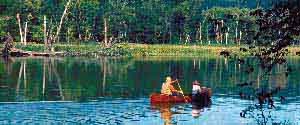| |

Upper Mississippi River National Wildlife & Fish Refuge
Soaring overhead, a bald eagle wheels and dives to catch a fish from the Upper Mississippi River National Wildlife and Fish Refuge. The 261-mile refuge is the longest river refuge in the continental U.S. The refuge begins at the confluence of the Chippewa River near Wabasha, Minnesota, and ends near Rock Island, Illinois. The refuge lies within four states: Minnesota, Wisconsin, Iowa, and Illinois.
The river was free-flowing until a series of locks and dams were constructed in the 1930s by the U.S. Army Corps of Engineers. Over half of the lands managed by the refuge are owned by the Corps. Today, nearly 240,000 acres of wooded islands, marshes, and backwaters comprise the Upper Miss Refuge. The refuge provides migratory habitat for a large percentage of the migratory birds in the Mississippi Flyway. Tundra swans and canvasback ducks use the refuge as a resting and feeding area in the spring and fall.
Getting There . . .
There are four district offices and a main headquarters. For more information on district opportunities and activities and detailed maps, go to the refuge's web site listed at the top of this page.
The headquarters and Winona District office are located in the Exchange Building at the corner of 4th and Center streets in Winona, Minnesota. From Highway 61, turn north on Huff street until it intersects with 4th Street; turn right. The Exchange Building is on the right-hand side of the road.
The LaCrosse District office is located in Onalaska, Wisconsin. From I-90, Exit 4, travel south on Highway 53/157. At the lights, turn left onto Highway 16. At the next stop sign, turn left onto Braund Street, then right onto County Road PH. Turn left onto Lester Avenue. The Office and Resource Center is at 555 Lester Avenue.
The McGregor District office is located at 401 Business Hwy 18 N, between the towns of McGregor and Marquette, Iowa.
The Savanna District office is located south of Savanna, Illinois. From Savanna, head south on Route 84 for 3.5 miles, turn right onto Riverview Road. Travel 0.5 miles to the office and visitor center.
Get Google map and directions to this refuge/WMD from a specified address: |
|
|
|

Environmental Education
Fishing
Hunting
Interpretation
Photography
Wildlife Observation
Learn
More >>


Restoring riverine habitat is the main focus of management activities. Projects include a mix of wetland management, grassland/forest management, and fish management. Types of projects include active water level management, island building, bank stabilization, oxygenation of backwaters, and dredging areas for over-wintering fish.
Other refuge programs include restoration of native grass prairie, forestry management work, waterfowl banding, invertebrate sampling, vegetative monitoring, heron and egret nest counts, and surveys for waterfowl, neotropical migrants, eagles, and marsh and water birds.
|
|

